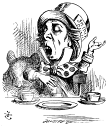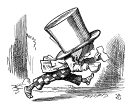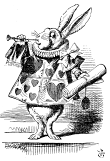Search us!
Search The Word Detective and our family of websites:
This is the easiest way to find a column on a particular word or phrase.
To search for a specific phrase, put it between quotation marks. (note: JavaScript must be turned on in your browser to view results.)
Ask a Question! Puzzled by Posh?
Confounded by Cattycorner?
Baffled by Balderdash?
Flummoxed by Flabbergast?
Perplexed by Pandemonium?
Nonplussed by... Nonplussed?
Annoyed by Alliteration?

Don't be shy!
Send in your question!
Columns from 1995 to 2006 are slowly being added to the above archives. For the moment, they can best be found by using the Search box at the top of this column.
 If you would like to be notified when each monthly update is posted here, sign up for our free email notification list.
If you would like to be notified when each monthly update is posted here, sign up for our free email notification list.
Trivia
All contents herein (except the illustrations, which are in the public domain) are Copyright © 1995-2020 Evan Morris & Kathy Wollard. Reproduction without written permission is prohibited, with the exception that teachers in public schools may duplicate and distribute the material here for classroom use.
Any typos found are yours to keep.
And remember, kids,
Semper Ubi Sub Ubi
|
Been there, gentrified that.
Dear Word Detective: Jade is a stone that is polished and set in a piece of jewelry. How did it turn into “old hat”? — Mike Henderson.
Good question. But is the expression “old hat” meaning “passé, unfashionable, antiquated” even valid any longer, when every trustafarian hipster infesting Brooklyn is sporting a thrift-store vintage fedora or pork-pie hat? As a former long-term resident of the Borough of Kings, I remember the old saying “Only the dead know Brooklyn.” That never seemed more true than late on a Saturday night when the D Train unexpectedly went express and dumped you in the rain out at Flatbush and Fuhgeddaboudit. Now, of course, there’s an app for that. But I can’t help hoping that someday that majestic, unknowable Brooklyn will rise from the deep like Godzilla and swallow up all those Warby Parker-wearing twerps. That would make a totally awesome Instagram.
Meanwhile, back at your question, the green stone known as “jade” and the world-weariness we call being “jaded” are two separate and completely unrelated words.
According to the Oxford English Dictionary (OED), “jade” the stone is actually two different kinds of stone sometimes traveling under the same name. “Jade” is, to quote the OED, “a silicate of lime and magnesia, a hard, translucent stone, in color light green, bluish, or whitish.” The light green variety of jade is of the color we normally call “jade.” The other sort of “jade” is properly called “jadeite,” and is a silica of sodium and aluminum which closely resembles actual jade (and also goes by the names “oriental jade” and “oceanic jade”).
This “jade” stone takes its name from the Latin “ilia,” which means the flanks or areas of the body near the kidneys; jade was, in fact, once thought to cure kidney problems. “Ilia” passed from Latin through the Spanish “ijada” into French, where the result, “l’ejade,” was mistakenly transformed into “le jade.” Voila, “jade.” Jade is also called “nephrite,” from the Greek “nephros,” kidney.
The world-weary kind of “jade” first appeared in English in the 14th century, most likely derived from the Old Norse “jalda,” meaning “mare.” In English, “jade” originally meant a work horse, especially an old, worn out mare. Inevitably, “jade” was eventually extended to people, particularly women of low social status, especially prostitutes (“A lying, prying, jilting, thievish jade.” 1812). The verb “to jade,” appearing in the early 17th century, originally meant to wear out a horse through hard work, but by the late 18th century it, too, was applied to people and the intransitive form came to mean “to become tired, exhausted, dull.”
By association with the use of the noun “jade” to mean “prostitute, underworld denizen,” the modern “jaded” implies that one has seen so many amazing, outrageous or scandalous things that one is no longer capable of taking either offense or excitement from the proceedings (“Call me jaded, but in a year that brings Oblivion, After Earth, World War Z, Pacific Rim, The World’s End and Smurfs 2, not just any old apocalypse will do.” National Post, 2013).
A room with vroom.
Dear Word Detective: I teach second grade in Southern California. I have a student that asked me where the word “caboose” came from. I’ve tried to find a source for this, but haven’t been very successful. Can you help me out? I’d sure appreciate it. Anything to spark interest in language! — S.M.
Spark interest in language, eh? I’m not so sure that’s a good idea. Of course, it’ll be cute at first, little nippers running around, running off at the mouth, saying cute things at breathtakingly inappropriate moments. After all, back in the 50s and 60s, Art Linkletter turned them into tiny cash cows with his “Kids Say the Darndest Things” books and TV shtick. But now the spotty little monsters have smartphones, access to the internet, their own Twitter and Facebook accounts, and apparently tireless thumbs. And if you think literacy is improving the world, I suggest you take a close look at trending topics on Twitter.
“Caboose” is defined by Merriam-Webster.com as “a part of a train that is attached at the back end and is used by people who work on the train,” which is like explaining an ocean liner as “a long, pointy thing that floats on the water.” It totally misses what makes a caboose cool. A “caboose” is a little house on wheels that hooks onto the back end of a train. It’s got windows, bunk beds, a galley for cooking and an office for the conductor. Some cabooses (I keep wanting to type “cabeese”) even have a little cupola on top so the conductor can keep an eye on things all the way to the front of the train.
The first “caboose,” however, had no connection to railroads. When the word first appeared in English in the mid-18th century, it meant a small cooking cabin or kitchen on the deck of a merchant sailing vessel. “Caboose” was also used to mean the cast iron cooking stove inside the cabin. The word “caboose” comes from the Dutch “kabuis” (or Low German “kabuse”) meaning “cabin on a ship’s deck.” The use of “caboose” to mean a crew car on a railway train arose in the mid-19th century. That was the beginning of the heyday of long-distance rail transport in the US, so it made sense to have eating and sleeping facilities on freight trains that often didn’t stop for hundreds of miles.
Cabooses seem neat today, and they were definitely a good idea in the 19th century, but train crews were apparently less than thrilled with the conditions in some cabooses, and slang terms such as ” the crummy,” “the hack,” “the doghouse,” “the bone-breaker,” “the clown wagon” and, ominously, “the hearse” were common.
According to what I’ve read online, “cabooses” are, sadly, going the way of the dodo, made unnecessary by technology and shorter rail runs. But I live about a mile north of a rail crossing with fair amount of train traffic, and I’m still seeing cabooses. Granted, that’s on moonlit nights and the trains make no noise as they pass, but I think it counts anyway.
A little dab will do ya.
Dear Word Detective: I think that the word “eke” is one of the strangest words in the English language. The meaning even seems a little nebulous. What is the history on this word? — Doris Render.
“Eke” is indeed a somewhat nebulous word. One might even say “eke” is oblique by design, because you can’t be sure what is meant by someone using it. If an old friend, encountered on the street after many years, says that he “manages to eke out a living,” he could be saying he squeaks by with odd jobs, perhaps tutoring the dim spawn of investment bankers. (I know people who have done this, and it isn’t pretty.) But he also might be an investment banker himself with a nine-figure income and a warped sense of humor.
In modern usage, “eke” is almost always found in the verb phrase “to eke out,” meaning “to get by” in a task or to narrowly achieve a goal by means of extra effort, thrift, or initiative. A good 80% of uses of “eke” I found on Google News today, for instance, are in sports stories about teams who managed to “eke out” a victory in the last quarter, inning or whatever.
Although “eke” is found only in its verb form today, it started as a noun. This “eke” meant “an addition, an increase” or “something added on.” The noun “eke” originally appeared in Old English, where it was used to mean reinforcements for troops in the field. The roots of “eke” lie in the Proto-Germanic “aukan,” which also eventually gave us the English “augment.”
“Eke” as a verb originally meant literally “to increase, to lengthen,” a sense which lives on in the use of “eke” or “eke out” to mean “to pad a speech or piece of writing in order to fill up time or meet a quota of words,” a device familiar to any student assigned a term paper (“To eke out any thing, signifies to lengthen it beyond its just dimensions by some low artifice.” Samuel Johnson, 1747).
Outside of the Sports pages or election returns, most of us probably rarely encounter “eke,” but nearly anyone who speaks English is familiar with a descendant of “eke,” albeit one disguised a bit by its own history.
A “nickname” is an “additional” name given to (or adopted by) a person. It may be a familiar form of their proper name (e.g., Chuck for Charles, Bill for William, etc.) or may be drawn from an avocation, hobby or distinguishing act or characteristic of the person. Nicknames exist in most human cultures, and in English they came to be known, in the 13th century, as “eke-names” or “ekenames,” names which were “added” to one’s existing name. Thus one would refer to one’s friend by an “ekename” such as “Moose” or “Binky.” Over the centuries, however, the “n” from “an” drifted over to the front of “ekename,” giving us “a nekename,” and eventually “a nickname.” This common linguistic process, called “metanalysis,” also transformed “a napron” (from the Old French “naperon,” tablecloth) into “an apron” during the same period.
|
Makes a great gift! Click cover for more.  
400+ pages of science questions answered and explained for kids -- and adults!
FROM ALTOIDS TO ZIMA, by Evan Morris
 
|


 can be found
can be found 




Recent Comments